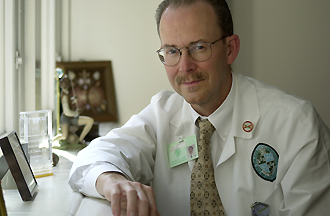Tulane scientists share Katrina experiences with Sandy survivors
A delegation from Tulane University visited New York University on Nov. 14 and 15 to discuss the impact of Hurricane Sandy on the NYU medical school and how lessons learned during and after Hurricane Katrina might help steer them through this crisis.

“We were impressed by their stories of resilience and heroism in evacuating patients from the hospital as the floodwaters rose,” says John Clements, who led a delegation from Tulane to New York University medical school. (Photo by Paula Burch-Celentano)
John Clements, Lisa Morici and Elizabeth “Betzi” Norton met with groups of students and postdoctoral fellows, faculty, department chairs and senior administrators.
“We avoided making direct comparisons between [hurricanes] Sandy and Katrina because every disaster is unique, but some of our experiences were very relevant,” says Clements, professor and chair of the Tulane Department of Microbiology and Immunology. “I reminded the NYU participants that the first fire truck I saw after Katrina was from New York. We have a special bond with them and this was an opportunity to reciprocate. We felt privileged to participate.”
Clements met first with the NYU emergency management team. He was impressed by how thoroughly the team has thought through some of their challenges, including relocating researchers, mitigation, insurance and animal facilities.
“I was equally impressed by their description of how pro-active FEMA and the NIH (National Institutes of Health) have been in responding to this emergency,” Clements says. “I know that many of the NIH policies put into place after Katrina (extensions, supplemental funding) were a direct result of Laura Levy's initiatives and interactions with the NIH.” Levy is vice president for research at Tulane.
The Tulane group met with a group of about 200 graduate students and postdoctoral fellows to relate “our own experiences and why we individually made the decision to re-commit to research and to Tulane University following Katrina.”
Clements also met with senior administrators, including the dean, his senior staff and members of the emergency management team, to walk them through his experience as the senior health sciences investigator on the ground following Katrina. He discussed how Tulane managed the process of bringing its downtown campus back on-line while preserving as many biologic assets as possible and allowing investigators access to their notes and research materials.
